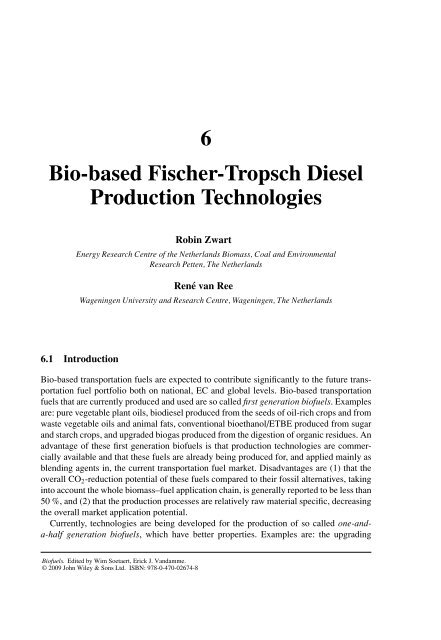Biofuels in Perspective
Biofuels in Perspective
Biofuels in Perspective
Create successful ePaper yourself
Turn your PDF publications into a flip-book with our unique Google optimized e-Paper software.
6<br />
Bio-based Fischer-Tropsch Diesel<br />
Production Technologies<br />
Rob<strong>in</strong> Zwart<br />
Energy Research Centre of the Netherlands Biomass, Coal and Environmental<br />
Research Petten, The Netherlands<br />
RenévanRee<br />
Wagen<strong>in</strong>gen University and Research Centre, Wagen<strong>in</strong>gen, The Netherlands<br />
6.1 Introduction<br />
Bio-based transportation fuels are expected to contribute significantly to the future transportation<br />
fuel portfolio both on national, EC and global levels. Bio-based transportation<br />
fuels that are currently produced and used are so called first generation biofuels. Examples<br />
are: pure vegetable plant oils, biodiesel produced from the seeds of oil-rich crops and from<br />
waste vegetable oils and animal fats, conventional bioethanol/ETBE produced from sugar<br />
and starch crops, and upgraded biogas produced from the digestion of organic residues. An<br />
advantage of these first generation biofuels is that production technologies are commercially<br />
available and that these fuels are already be<strong>in</strong>g produced for, and applied ma<strong>in</strong>ly as<br />
blend<strong>in</strong>g agents <strong>in</strong>, the current transportation fuel market. Disadvantages are (1) that the<br />
overall CO2-reduction potential of these fuels compared to their fossil alternatives, tak<strong>in</strong>g<br />
<strong>in</strong>to account the whole biomass–fuel application cha<strong>in</strong>, is generally reported to be less than<br />
50 %, and (2) that the production processes are relatively raw material specific, decreas<strong>in</strong>g<br />
the overall market application potential.<br />
Currently, technologies are be<strong>in</strong>g developed for the production of so called one-anda-half<br />
generation biofuels, which have better properties. Examples are: the upgrad<strong>in</strong>g<br />
<strong>Biofuels</strong>. Edited by Wim Soetaert, Erick J. Vandamme.<br />
© 2009 John Wiley & Sons Ltd. ISBN: 978-0-470-02674-8








